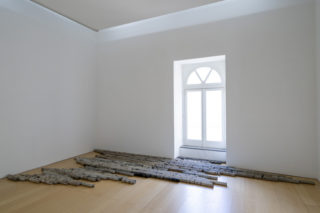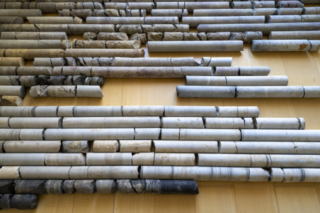

Produttivo 2018-2019
Core samples (vulcanite, siltstone, sandstone, lumachella limestone, microconglomerate, carbonaceous layers, miliolidae limestone)
Gift of the artist to the Fondazione Donnareggina per le arti contemporanee – Madre · Museo d’arte contemporanea Donnaregina in the context of the territorial displacement of the ‘Produttivo’ (coal seam) in collaboration with Amaci. Co-produced by the Fondazione Pirelli HangarBicocca, Milan.
Giorgio Andreotta Calò works with found material fragments and the reappropriation of elements of architecture, landscape and history. His works navigate between sculpture, performative actions and direct architectural interventions, often resulting from durational research-based processes. Calò’s practice is rooted in fieldwork and investigates notions of resource and stratification, both material and symbolic, to address the ecological and social repercussions of extractive processes. Produttivo features geological core samples obtained by the artist from the archive of Carbosulcis S.p.A., the last company active in Italy in the extraction of coal, which ended its mining activity in 2017. The stratigraphic sequences were originally sourced in the Sulcis-Iglesiente area of the southwest of Sardinia in investigating the mining potential of the local coal reserves. The title of the work references the productive coal seam for mining, sampled at depths of 350 – 450 metres below sea level. The 2000 linear meters of rock samples he acquired, reordered and catalogued are presented as collective heritage rather than mere records of resource deposits. The samples which originated from the same area then underwent a process of geographical displacement: groups of cores were donated by the artist to eleven Italian museums, following a distribution from the north to the south of the country in accordance with the depth of their extraction. Calò’s work reflects on the transformation of matter across time, its material layers correspond to the geological eras of a specific site’s subsoil. By configuring horizontally the stratigraphic cores, Produttivo articulates a geological timeline through the different textures and colours of the materials gathered, offering a chronology of environmental history and human extractive activities that is also like a continuous line of script running left to right across the floor. Andreotta Calò also thinks of the work as making visible an underground fossil forest in the veins of coal within the rock, the result of seemingly alchemical transformations across the millennia.
Artist statement
At the time, these core samples had acquired the status of inert material, material that would simply be disposed of – there was no interest in preserving it as a geognostic archive. However, I was interested in conserving them as a testimony to what had been done in the area, and so I tried to save and recover them, in the form of a work of art. The entire ‘Produttivo’ was divided into twelve stratigraphic families, each donated to eleven Italian museums, located throughout the country, with an arrangement according to these families. <in this way, it was possible to transform the work into shared heritage, and therefore also to change its value and nature, to rethink the nature of this work and its status. No longer material that produces energy, it became an object producing synergies and activating connections between institutions to gives new meaning to the material. This reasoning implies a paradigm shift, a revolution in cultural value or thought, that allows a re-evaluation of the nature of an object and of reality, causing the material to be re-evaluated as something other than what it represents or the reason for which it was produced.